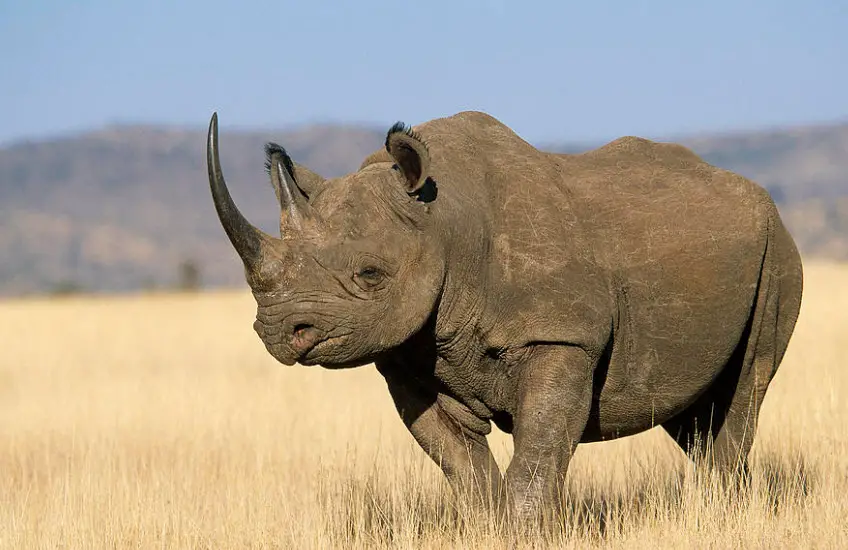The black rhinoceros (Diceros bicornis) is a native mammal of Africa that is typically found in the savanna vegetation of southwest Cape to Somaliland. Like other rhinos, the black rhino is also solitary except during the breeding season. It is also called the hook-lipped rhinoceros. The animal is critically endangered.
Black Rhino Facts
Anatomy
- The shoulder height of adult rhinos is 140–180 cm (55–71 in) with the head-body length measuring about 112–120 in (286–305 cm).
- Black rhinos weigh up to 2,100–2,900 lb (950–1,300 kg).
- They have gray to brownish gray skin and it lacks hair.
- It has got prehensile upper lip which is extremely useful in grasping food. That is why they are so named.
- The length of the anterior horn is about 16.5–54 in (42–138 cm) with the posterior horn averages 8–20 in (20–50 cm).
- Males are generally larger than the females.
- They use horns not only for defense but also for digging up roots.
- It is nearly the size of Javan rhino but black rhinos are smaller than white rhinoceros.
Read More:

Distribution
- Black rhinos once occupied much of Africa—from Cameroon to Ivory Coast as well as in Tanzania, Namibia, Zimbabwe, Kenya, and Angola. However the population is on the decreasing trend and the rhino is barely found in the wild except in natural reserves.
- They are totally protected as IUCN has listed them as critically endangered species.
Habitat
- Black rhinos make homes in savanna vegetation including arid shrub steppe. The habitat doesn’t include evergreen rainforest.
- The black rhino’s habitat also includes riverine woodland, grasslands, marshes, and bushlands.
Behavior
- The black rhinoceros is an exclusively solitary animal outside the breeding season.
- They are not thought to be territorial and their range often overlaps with that of other species.
- Black rhinos do not have fixed home range as it varies with the availability of food.
- The home range in Serengeti is 70 to 100 km2 (27 to 39 sq mi) while in Ngorongoro it is around 2.6 to 58.0 km2 (1.0 to 22.4 sq mi).
- Females tend to have greater range as compared to males.
- In captivity, male rhinos are believed to sleep longer than the females.
- They are aggressive animals and might not hesitate to charge against any threat.
- Black rhinoceros frequently fight with each other so much so that they have the highest rates of mortal fight among all mammals.
- They don’t seem to have any natural predator. Young rhinos may fall prey to crocodiles or lions.
- They are quite fast attaining a speed of 55 km/h (34 mph).
- They may be found lying in a mud or in dust hollows.
- Sometimes black rhinos become active at night than at day.

Feeding Ecology & Diet
- Black rhinos are typically browsers and they feed on shoots, branches, leafy plants, fruits, and thorny wood bushes.
- They are likely to stay in habitats that are abundant in dense shrubs along with woodlands or bushland.
- They are thought to consume as much as 220 species of plants.
- Black rhinos prefer eating woody plants, Acacia spp. It can go by 4 – 5 days without drinking. They eat shrubs or small saplings that are 5 ft (1.5 m) high.
- They may eat either in morning or at evening.
- Rhinos will rip the branches off the ground that are 0.4 in (10 mm) thick and reaches a length of 4–9.8 in (100–250 mm).
- They have poor eyesight but rhinos rely on scent marking to trace their counterparts.
- Often they spray urine in water holes, bushes or trees.
- They will drink more often if the water is abundant. Black rhinos searches for water in the late afternoon and at the start of the night.
Reproductive Biology
- Mating occurs all year round. In South Africa, they mate in early summer. Before mating, a male must spend 6 – 7 days with the female.
- A single calf is born after a gestation period of about 15 months.
- The calf averages 9–11 lb (20–25 kg) in weight. It also produces mewing squeals if parted from the mother.
- The mother will nurse the calf until it attains 1.5 year age.
- There is an interval of 2 to 2.5 years between births. The young will disperse once it is 2.2 – 3.3 years old.
- Females attain the maturity at 4.5 years age but it may not give birth until it reaches 6 years. Males become mature around 8 – 9 years of age.
- The maximum lifespan in captivity is 49 years while in the wild they live up to 35 years.
Conservation Status
Critically Endangered





